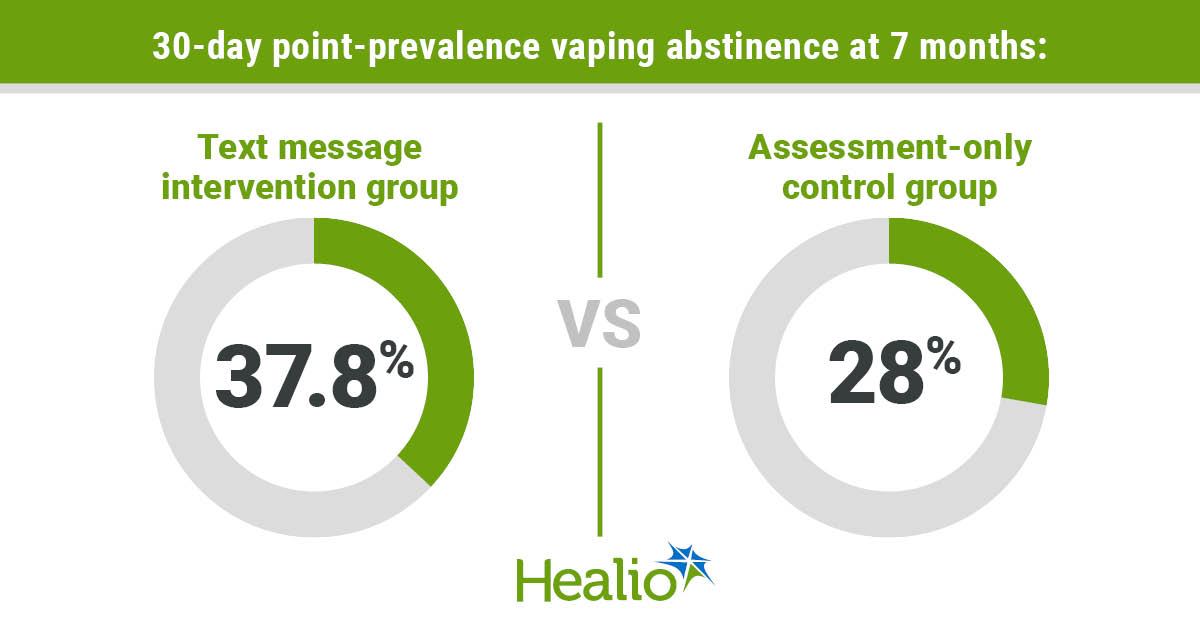
August 08, 2024
4 min read
Add topic to email alerts
Receive an email when new articles are posted on
Please provide your email address to receive an email when new articles are posted on . We were unable to process your request. Please try again later. If you continue to have this issue please contact [email protected].
Key takeaways:
- This study used Truth Initiative’s This is Quitting automated, interactive text message program for vaping cessation.
- At 7 months, the abstinence rate was higher in the intervention vs. assessment-only group.
Receiving daily text messages as part of an e-cigarette cessation intervention led to a larger vaping abstinence rate at 7 months vs. a control treatment in adolescents, according to results published inJAMA.

Amanda L. Graham
“The text message intervention helped adolescents in this study build confidence to overcome nicotine addiction and learn powerful behavior change skills that they can take with them for life,”Amanda L. Graham, PhD, chief health officer of innovations at Truth Initiative, told Healio.
 Data were derived from Graham AL, et al. JAMA. 2024;doi:10.1001/jama.2024.11057.
Data were derived from Graham AL, et al. JAMA. 2024;doi:10.1001/jama.2024.11057.
“This is the first study to demonstrate the effectiveness of any quit vaping program for adolescents,” Graham added. “It’s also a program that has been used by more than 780,000 young people nationwide since Truth Initiative launched it in 2019.”
In a parallel, two-group, double-blind, individually randomized clinical trial, Graham and colleagues evaluated 1,503 adolescents (mean age, 16.4 years; 50.6% girls; 7.4% nonbinary/other; 42.5% sexual minority) aged 13 to 17 years with e-cigarette use in the past 30 days, as well as a desire to quit, to determine if an automated, interactive text message program for vaping cessation (This is Quitting) plus a monthly text message assessing e-cigarette use results in higher 30-day point-prevalence abstinence at 7 months vs. the monthly assessment text alone.
Notably, texts sent in the intervention group provided cognitive and behavioral coping skills training and social support, according to researchers.
As Healio previously reported, young adults aged 18 to 24 years who received daily text messages as part of an e-cigarette cessation intervention reported higher rates of nicotine abstinence compared with a control group.
The total cohort included 62.6% of individuals who identified as white, 10.2% who identified as Black/African American, 18.5% who identified as multiracial, and 8.7% who identified as another race, as well as 16.2% who identified as Hispanic.
The intervention group was made up of 759 adolescents, and the assessment-only control group was made up of 744 adolescents. Both groups had similar demographic characteristics.
At baseline, more than three-quarters (76.2%) of adolescents reported vaping within 30 minutes of waking up. This measure and four others revealed that the population had a moderate-high level of nicotine/e-cigarette dependence, which Graham said was surprising.
“These data likely reflect the fact that e-cigarette products have changed in recent years, delivering stronger concentrations of nicotine in larger devices at lower cost,” Graham told Healio.
A large proportion of the total population (87.3%) attempted to quit vaping in the past year, with over half (53.4%) reporting at least three attempts.
Of the total study population, 70.8% completed a 7-month follow-up.
At this follow-up, the abstinence rate was higher in the intervention group vs. the assessment-only group (37.8% vs. 28%; RR = 1.35; 95% CI, 1.17-1.57; P < .001).
Notably, in the previously mentioned trial of individuals aged 18 to 24 years, the abstinence rate was 24.1% in the intervention group and 18.6% in the control group (OR = 1.39; 95% CI, 1.15-1.68) at 7 months.
“The fact that quit rates among adolescents in this trial were roughly 10 percentage points higher than those among young adults several years ago [was surprising],” Graham told Healio. “This may point to the changing norms around e-cigarette use and the fact that quitting vaping among young people is becoming more normative and accepted.”
The link between treatment and 30-day point-prevalence abstinence rates did not change based on any baseline variable, according to researchers.
In terms of abstinence among the 418 adolescents with baseline use of both e-cigarettes and a combustible tobacco product (cigarettes, little cigars, cigarillos, large cigars), 43.8% stopped using both items at 7 months.
Additionally, researchers found that fewer adolescents reported past 30-day combustible tobacco product use at 7 months vs. baseline (24.1% vs. 41.1%).
At 7 months, dual abstinence was greater in the intervention group vs. the assessment-only group in both the subset of adolescents with dual use (50.8% vs. 30%; P < .001) and the subset with exclusive e-cigarette use (54.3% vs. 38.6%; P = .001).
Lastly, combustible tobacco product use at 7 months was low (3.4%) in the group of adolescents with baseline exclusive e-cigarette use who quit vaping.
“Since the Surgeon General first declared youth vaping a public health epidemic, there has been no scientific evidence to tell parents, health care providers and public health professionals how best to help adolescent e-cigarette users to quit,” Graham told Healio. “This study fills an important gap in the literature and can serve as a benchmark to inform future efforts.”
Graham added, “this kind of peer support says to other young e-cigarette users that they are not alone in quitting, that the ups and downs throughout the quitting journey are normal, and that quitting for good is possible.”
Moving forward, Graham said there is a need for many different interventions/treatments to help adolescents using e-cigarettes.
“No one treatment approach can be expected to meet the needs of the 2.1 million adolescents who use e-cigarettes,” she told Healio. “It will be important to understand the role of different approaches for different types of adolescent e-cigarette users.”
Free resources on quit support for smoking and vaping for use in clinics are available at truthinitiative.org/exprogram.
“Adolescents may not disclose that they are using e-cigarettes to a clinician, so it’s important to find other ways to let teens know that support is available,” Graham said.
Reference:
Add topic to email alerts
Receive an email when new articles are posted on
Please provide your email address to receive an email when new articles are posted on . We were unable to process your request. Please try again later. If you continue to have this issue please contact [email protected].




